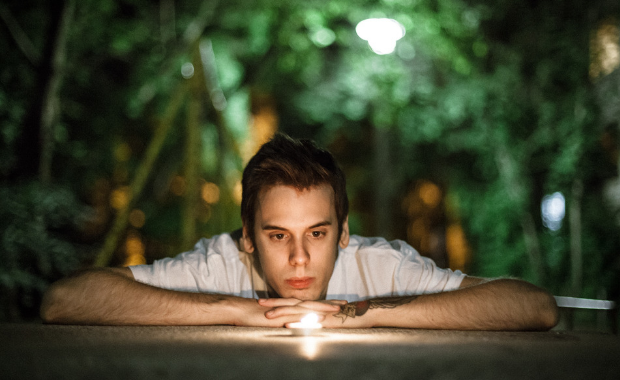Life
Meditation for Beginners: How It Works and Where to Start

Meditation was first developed in India many years ago (around 5000-3500 BCE). It took quite some time to become popular in the western world, but today, it is celebrated as a therapeutic tool to ease stress, anxiety, depression, and addictions. In the past years, it has also become recognized as helping to improve mental performance, and consequently became a multi-billion dollar business. If you’ve never tried it, you may be wondering how something so simple as sitting with your eyes closed could deliver such incredible benefits.
How meditation works
Meditation is about training in awareness and getting a healthy sense of perspective over one’s thoughts. Many think that meditating is about trying to achieve a zen state of mind, but that’s not the point. Observing one’s thoughts, and then letting go of them so that eventually you may start to better understand them, is the real goal of each meditation practice.
There are different techniques to go through this mental process. Some focus on the breath and bodily sensation, others make you visualize an object, and others help you to channel your thoughts towards acts of love and kindness.
A typical meditation session involves you sitting on a chair or cross-legged on the floor with your eyes closed. Once you assume a comfortable position and focus on your breath, you should start noticing your thoughts. At this point, according to what type of technique you’re using, you will try to let those thoughts go away by focusing on something else (this could be your breath or a mental image you created).
With time and practice, you may be able to reach a state of mind where very few thoughts (or none) are present. Despite the simplicity of this process, meditating for more than ten minutes is extremely tough for most. Many people that try meditation get discouraged by the fact that “they can’t stop thinking.” In fact, it has been proven that people spend most of their days being anything but mindful and peaceful.
In a 2010 study, Harvard researchers asked more than 2000 adults about their thoughts and actions at random moments throughout their day via an iPhone app. People’s minds wandered 47% of the time, and mind wandering often triggered unhappiness, the scientists reported.
They also observed that spending time observing our thoughts without getting stuck on them, may help to better understand oneself, and possibly being able to reduce the number of negative thoughts one experiences.
“The mind is definitely something that can be transformed, and meditation is a means to transform it.” – Dalai Lama
What science says about meditation
People have practiced meditation for thousands of years, but scientists have studied its effects for only a dozen. In the past few years, many studies have been published about the neurological benefits of meditation, proving it to improve brain function in many different ways.
Meditation’s benefits range from preserving the aging brain, to improving happiness by reducing the activity of the brain’s “me center” (monkey mind). A more recent study has even proven that meditation is as powerful as antidepressants in treating depression, anxiety, and pain. Many more studies are being conducted every day on meditation, and we can expect to gain a lot more insight in the near future.
Can anyone meditate?
Millions of people are practicing mindfulness meditation every day with great results, but there are also as many people that have tried meditating and didn’t like it or didn’t manage to be consistent with their practice. The most important part of developing a meditation practice is consistency. You don’t have to meditate every single day, but the benefits are tied to regular, consistent practice.
Some studies claim that some benefits of meditation such as improved mood, decreased stress and decreased blood pressure, can be felt after a single session. Some other benefits like increased focus and decreased anxiety may be experienced after a few weeks and others take longer to develop.
Some people claim that as little as five minutes of meditation per day can make miracles, but research shows that a regular practice associated with benefits involves 10-20 minutes of meditation at least three times per week.
“Be happy in the moment, that’s enough. Each moment is all we need, not more.” – Mother Teresa
What’s the best way to begin a meditation practice?
A good place to start for aspiring mediators is Headspace. Andy Puddicombe, a former English student in sport science, dropped his studies to travel to Asia and trained as a Buddhist monk. He created Headspace with the goal of helping millions of people to live a more mindful life. Over 30 million people have downloaded and use headspace. This is due to his simplicity and its beautiful design and animations.
Do you meditate? If so, what’s your favorite aspect of it? Share your thoughts below!
Did You Know
How Skilled Migrants Are Building Successful Careers After Moving Countries
Behind every successful skilled migrant career is a mix of resilience, strategy, and navigating systems built for locals.

Moving to a new country for work is exciting, but it can also be unnerving. Skilled migrants leave behind familiar systems, networks, and support to pursue better job opportunities and a better future for their families. (more…)
Life
10 Research-Backed Steps to Create Real Change This New Year
This New Year could finally be the one where you break old patterns and create real, lasting change.

Every New Year, we make plans and set goals, but often repeat old patterns. (more…)
Life
9 Harsh Truths Every Young Man Must Face to Succeed in the Modern World
Before chasing success, every young man needs to face these 9 brutal realities shaping masculinity in the modern world.

Many young men today quietly battle depression, loneliness, and a sense of confusion about who they’re meant to be.
Some blame the lack of deep friendships or romantic relationships. Others feel lost in a digital world that often labels traditional masculinity as “toxic.”
But the truth is this: becoming a man in the modern age takes more than just surviving. It takes resilience, direction, and a willingness to grow even when no one’s watching.
Success doesn’t arrive by accident or luck. It’s built on discipline, sacrifice, and consistency.
Here are 9 harsh truths every young man should know if he wants to thrive, not just survive, in the digital age.
1. Never Use Your Illness as an Excuse
As Dr. Jordan B. Peterson often says, successful people don’t complain; they act.
Your illness, hardship, or struggle shouldn’t define your limits; it should define your motivation. Rest when you must, but always get back up and keep building your dreams. Motivation doesn’t appear magically. It comes after you take action.
Here are five key lessons I’ve learned from Dr. Peterson:
-
Learn to write clearly; clarity of thought makes you dangerous.
-
Read quality literature in your free time.
-
Nurture a strong relationship with your family.
-
Share your ideas publicly; your voice matters.
-
Become a “monster”, powerful, but disciplined enough to control it.
The best leaders and thinkers are grounded. They welcome criticism, adapt quickly, and keep moving forward no matter what.
2. You Can’t Please Everyone And That’s Okay
You don’t need a crowd of people to feel fulfilled. You need a few friends who genuinely accept you for who you are.
If your circle doesn’t bring out your best, it’s okay to walk away. Solitude can be a powerful teacher. It gives you space to understand what you truly want from life. Remember, successful men aren’t people-pleasers; they’re purpose-driven.
3. You Can Control the Process, Not the Outcome
Especially in creative work, writing, business, or content creation, you control effort, not results.
You might publish two articles a day, but you can’t dictate which one will go viral. Focus on mastery, not metrics. Many great writers toiled for years in obscurity before anyone noticed them. Rejection, criticism, and indifference are all part of the path.
The best creators focus on storytelling, not applause.
4. Rejection Is Never Personal
Rejection doesn’t mean you’re unworthy. It simply means your offer, idea, or timing didn’t align.
Every successful person has faced rejection repeatedly. What separates them is persistence and perspective. They see rejection as feedback, not failure. The faster you learn that truth, the faster you’ll grow.
5. Women Value Comfort and Security
Understanding women requires maturity and empathy.
Through books, lectures, and personal growth, I’ve learned that most women desire a man who is grounded, intelligent, confident, emotionally stable, and consistent. Some want humor, others intellect, but nearly all want to feel safe and supported.
Instead of chasing attention, work on self-improvement. Build competence and confidence, and the rest will follow naturally.
6. There’s No Such Thing as Failure, Only Lessons
A powerful lesson from Neuro-Linguistic Programming: failure only exists when you stop trying.
Every mistake brings data. Every setback builds wisdom. The most successful men aren’t fearless. They’ve simply learned to act despite fear.
Be proud of your scars. They’re proof you were brave enough to try.
7. Public Speaking Is an Art Form
Public speaking is one of the most valuable and underrated skills a man can master.
It’s not about perfection; it’s about connection. The best speakers tell stories, inspire confidence, and make people feel seen. They research deeply, speak honestly, and practice relentlessly.
If you can speak well, you can lead, sell, teach, and inspire. Start small, practice at work, in class, or even in front of a mirror, and watch your confidence skyrocket.
8. Teaching Is Leadership in Disguise
Great teachers are not just knowledgeable. They’re brave, compassionate, and disciplined.
Teaching forces you to articulate what you know, and in doing so, you master it at a deeper level. Whether you’re mentoring a peer, leading a team, or sharing insights online, teaching refines your purpose.
Lifelong learners become lifelong leaders.
9. Study Human Nature to Achieve Your Dreams
One of the toughest lessons to accept: most people are self-interested.
That’s not cynicism, it’s human nature. Understanding this helps you navigate relationships, business, and communication more effectively.
Everyone has a darker side, but successful people learn to channel theirs productively into discipline, creativity, and drive.
Psychology isn’t just theory; it’s a toolkit. Learn how people think, act, and decide, and you’ll know how to lead them, influence them, and even understand yourself better.
Final Thoughts
The digital age offers endless opportunities, but only to those who are willing to take responsibility, confront discomfort, and keep improving.
Becoming a man today means embracing the hard truths most avoid.
Because at the end of the day, success isn’t about luck. It’s about who you become when life tests you the most.
Change Your Mindset
The Four Types of Happiness: Which One Are You Living In?
Most people chase success only to find emptiness, this model reveals why true happiness lies somewhere else.

In a world driven by rapid technological growth and constant competition, many people unknowingly trade joy for achievement. (more…)
-

 Business4 weeks ago
Business4 weeks agoWhy Your E-Commerce Fulfilment Is Probably Broken (And How to Fix It)
-

 Shift Your Mindset4 weeks ago
Shift Your Mindset4 weeks ago11 E’s That Define Every Great Leader And Why Most People Miss Them
-

 Did You Know3 weeks ago
Did You Know3 weeks agoThe Success Patterns You Inherited (And Didn’t Notice)
-

 Entrepreneurs2 weeks ago
Entrepreneurs2 weeks agoThe Essential Skills Every Entrepreneur Needs In 2026
-

 Business3 weeks ago
Business3 weeks agoThe Hidden Money Pit in Your Operations (and How to Use It)
-

 Change Your Mindset2 weeks ago
Change Your Mindset2 weeks agoHow to Turn Your Mind Into Your Greatest Asset (Instead of Your Enemy)
-

 Change Your Mindset2 weeks ago
Change Your Mindset2 weeks agoThe Silent Skill That Makes People Respect You Instantly
-

 Life1 week ago
Life1 week ago10 Research-Backed Steps to Create Real Change This New Year



























2 Comments